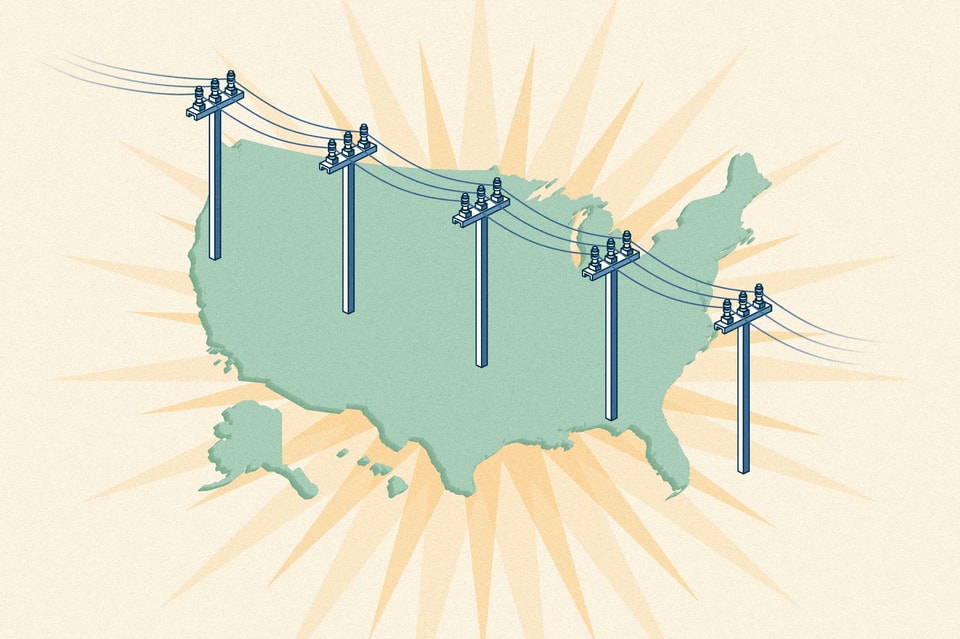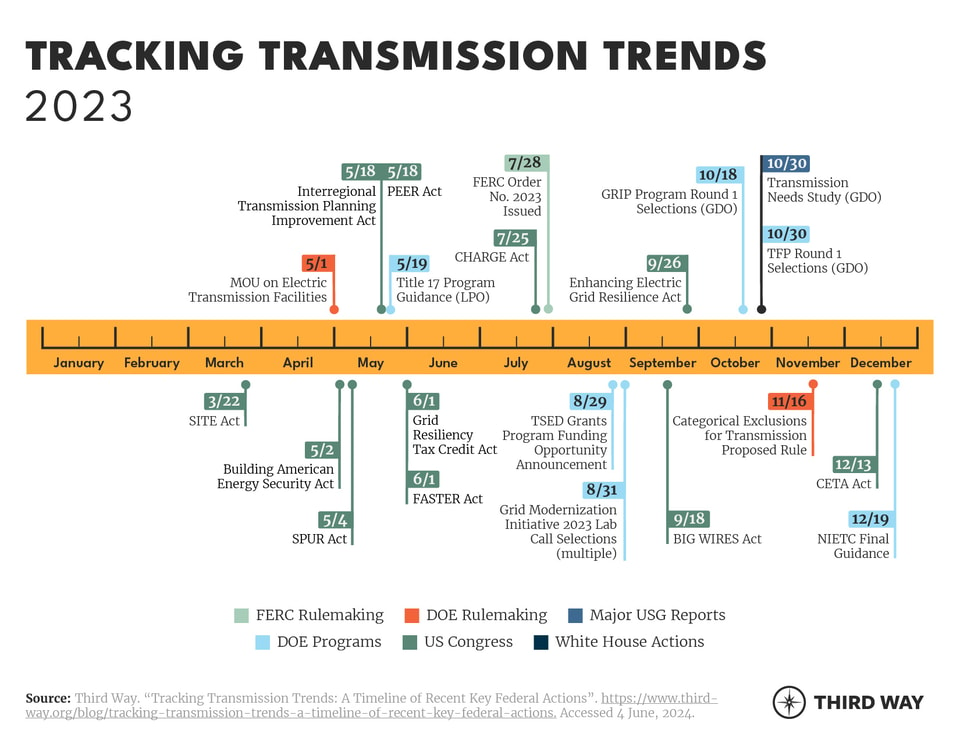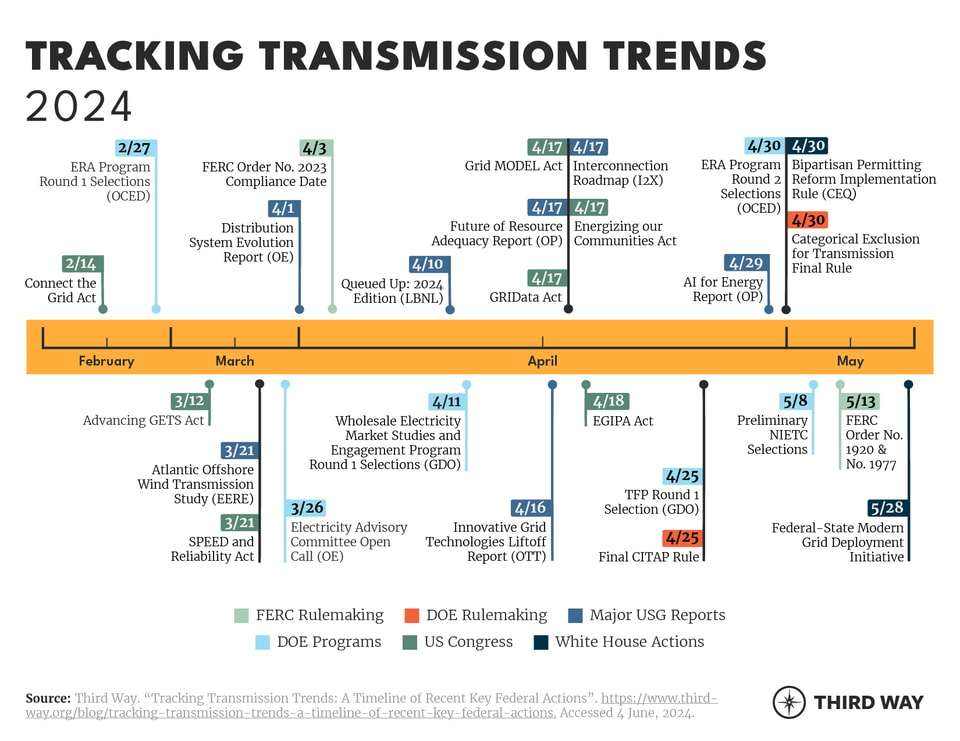Blog Published June 20, 2024 · 15 minute read
Tracking Transmission Trends: A Timeline of Recent Key Federal Actions
Kelsey Murlless & Shane Londagin

To ensure a reliable, resilient, and clean power system, the US needs to build over 75,000 miles of new transmission infrastructure over the next 11 years. But with extensive challenges facing the power sector—aging infrastructure, siting and permitting delays, cost allocation issues, insufficient long-term planning, interconnection queue backlogs, and partisan feuding—progress is slow, with only 255 miles of new transmission construction across the country in 2023.
Having recognized the scale of this challenge, the Biden Administration and Congress recently released a slew of new bills, programs, reports, and regulations that will pave the way for new and improved electric infrastructure while streamlining the processes toward modernization.
This timeline provides an overview of key actions from Congress, the White House, the Federal Energy Regulatory Commision (FERC), and the Department of Energy (DOE) over the past two years, highlighting the whole-of-government approach needed to light the path for the grid of the future.
Use the jump to section panel on the left to quickly navigate to brief explanations of every action on these timelines.


US Congress
Advancing Grid Enhancing Technologies (GETs) Act: This bill (S.3918/H.R. 7624) directs FERC to establish a shared savings incentive for GETs. This would allow developers to recoup some of their project costs while splitting cost savings with ratepayers.
- Introduced on: March 12, 2024
- Introduced by: Senator Welch (D-VT), Representative Castor (D-FL-14)
- Co-sponsored by: Senator King (I-ME) and Representatives Tonko (D-NY-20), Peters (D-CA-50), Casten (D-IL-06), and Kuster (D-NH-2)
Building American Energy Security Act: This bill (S.1399) aims to accelerate the permitting of energy and mineral infrastructure by setting maximum timelines for permitting reviews, expanding the scope of the Federal Permitting Improvement Steering Council, improving the NEPA categorical exclusion process, and setting limitations for court challenges.
- Introduced on: May 2, 2023
- Introduced by: Senator Manchin (D-WV)
Building Integrated Grids with Inter-Regional Energy Supply (BIG WIRES) Act: This bill (S.2827/H.R.5551) requires RTOs and ISOs to establish a minimum transfer capacity requirement set at 30% of their peak loads to increase grid reliability and lower costs.
- Introduced on: September 18, 2023
- Introduced by: Senator Hickenlooper (D-CO) and Representative Peters (D-CA-50)
Clean Electricity and Transmission Acceleration (CETA) Act: This bill (H.R.6747) aims to accelerate the deployment of transmission lines across the county by directing FERC to conduct a variety of activities including, but not limited to, improving interregional transmission planning and siting activities, creating a transmission investment tax credit, and establishing a minimum transfer capacity requirement between regions.
- Introduced on: December 13, 2023
- Introduced by: Representatives Casten (D-IL-06) and Levin (D-CA-49)
- Cosponsored by: 80 Democratic Representatives
Connecting Hard-to-Reach Areas with Renewably Generated Energy (CHARGE) Act: This bill (S.2480/H.R.5154) was reintroduced in 2023 to direct FERC to modernize transmission planning, increase data transparency, and increase oversight practices.
- Introduced on: July 25, 2023
- Introduced by: Senator Markey (D-MA) and Representative Ocasio-Cortez (D-NY-14)
- Cosponsored by: Over 30 Democratic Senators and Representatives
Connecting the Grid Act: This bill (H.R. 7348/S.3855) requires the Electric Reliability Council of Texas (ERCOT) to build transmission connections with the Western Interconnection, Southwest Power Pool (SPP), and Midcontinent Independent System Operator (MISO) to support grid reliability.
- Introduced on: February 14, 2024
- Introduced by: Representative Casar (D-TX-35) and Senator Markey (D-MA)
- Cosponsored by: 20 Democratic Representatives and Senator Merkley (D-OR)
Energizing our Communities Act: This bill (S. 4154/H.R. 8047) sets up a program that provides financial assistance to communities hosting DOE-supported transmission projects.
- Introduced on: April 17, 2024
- Introduced by: Senator Welch (D-VT) and Representative Kuster (D-NH-02)
Enhancing Electric Grid Resilience Act: This bill (S.2915/H.R.2750) requires FERC to establish cost allocation measures for the construction of interregional and offshore transmission based on reliability, resilience, and environmental benefits.
- Introduced on: September 26, 2023
- Introduced by: Senator Welch (D-VT) and Representative Castor (D-FL-14)
Expediting Generator Interconnection Procedures Act (EGIPA): This bill (S. 4190/H.R.8085) builds on FERC Order No. 2023 by directing FERC to streamline the interconnection study process, making it more transparent, predictable, and efficient.
- Introduced on: April 18, 2024
- Introduced by: Senator Cortez Masto (D- NV) and Representative Castor (D-FL-14)
Facilitating America’s Siting of Transmission and Electric Reliability (FASTER) Act: This bill (S.1804/H.R.4689) expedites transmission siting by designating FERC as the lead authority in coordinating NIETC authorizations and streamlining the grant application process for DOEs Transmission Siting and Economic Development Grant (TSEDG) Program
- Introduced on: June 1, 2023
- Introduced by: Senator Heinrich (D-NM) and Representatives Peters (D-CA-50),
- Sponsored by: Representatives Veasey (D-TX-33), and Cardenas (D-CA-29)
Grid Modeling of Dynamic Energy Loads and Resources (Grid MODEL) Act: This bill (S.4144) directs FERC and NERC to create reliability standards for resource adequacy modeling and integrated resource planning.
- Introduced on: April 17, 2024
- Introduced by: Senator Heinrich (D-NM)
- Cosponsored by: Senators Wyden (D-OR) and Padilla (D-CA)
Grid Reliability and Integrated Data (GRIData) Act: This bill (S. 4140) requires DOE to share and analyze more granular data highlighting where energy reliability improvements are required and how weather impacts reliability needs. This bill would allow DOE to serve as an information-sharing hub for energy reliability and modeling data.
- Introduced on: April 17, 2024
- Introduced by: Senators Henrich (D-NM)
- Cosponsored by: Senators Wyden (D-OR) and Padilla (D-CA)
Grid Resiliency Tax Credit Act: This bill (S.1793/H.R.5803) creates a 30% investment tax credit applicable to new large-scale transmission projects and grid enhancing technologies (GETs).
- Introduced on: June 1, 2023
- Introduced by: Senator Heinrich (D-NM) and Representative Horsford (D-NV-04)
- Cosponsored by: Senator Padilla (D-CA) and Representative Lee (D-NV-03)
Interregional Transmission Planning Improvement Act: This bill (S.1748) directs FERC to create an interregional transmission planning process and cost allocation measures that consider reliability, economic, and operational benefits.
- Introduced on: May 18, 2023
- Introduced by: Senator Heinrich (D-NM)
Promoting Efficient and Engaged Reviews (PEER) Act: This bill would streamline the permitting process and accelerate the deployment of transmission lines. Specifically, the bill combines the measures set forth in the CHARGE and SITE Acts to improve transmission siting, planning, and cost allocation.
- Released on: May 18, 2023
- Released by: Senators Carper (D-DE), Schatz (D-HI), Whitehouse (D-RI), Smith (D-MN), and Padilla (D-CA)
Streamlining Interstate Transmission of Electricity (SITE) Act: This bill (S.946/H.R.1766) establishes a new siting authority at FERC to streamline the construction of high-voltage, interregional transmission lines.
- Introduced on: March 22, 2023
- Introduced by: Senator Whitehouse (D-RI) and Representative Quigley (D-IL-05)
- Cosponsored by: Senators Hickenlooper (D-CO) and Henrich (D-NM) and Representatives Peters (D-CA-50) and Casten (D-IL-06)
Spur Permitting of Underdeveloped Resources Act (SPUR) Act: This bill (S.1456) streamlines the permitting process for energy infrastructure including both transmission lines and pipelines.
- Introduced on: May 4, 2023
- Introduced by: Senator Barasso (R-WY)
- Cosponsored by: 12 Republican Senators
Streamlining Powerlines Essential to Electric Demand (SPEED) and Reliability Act: This bill (S.4027/ H.R.7786) streamlines the siting and permitting process for interregional transmission lines by requiring FERC to only conduct one environmental review while allowing state and federal reviews to occur at the same time.
- Introduced on: March 21, 2024
- Introduced by: Senator Hickenlooper (D-CO) and Representative Peters (D-CA-50)
DOE Rulemaking
Categorical Exclusions for Transmission: This rule adds a NEPA categorical exclusion for specific energy storage projects while revising categorical exclusions for transmission and solar PV. The original categorical exclusion for transmission only applied to lines shorter than 20 miles. The revised rule removes this limit while creating pathways for relocating transmission lines within an existing right-of-way.
- Proposed rule published in Federal Register on: November 16, 2023
- Final rule published in the Federal Register on: April 30, 2024
Coordinated Interagency Transmission Authorizations and Permits (CITAP) Program: The CITAP Program aims to streamline the transmission development process by designating DOE as the lead agency coordinating environmental reviews and authorizations, setting a two-year deadline for agencies to issue permits and authorizations, creating a central online portal for agency coordination, and increasing community engagement between transmission developers and the public. This program derives its legal authority from the MOU on Electric Transmission Facilities.
- Final rule released on: April 25, 2024
Memorandum of Understanding (MOU) Regarding Facilitating Federal Authorizations for Electric Transmission Facilities: This MOU, signed by nine federal agencies, sought to streamline the siting and permitting process for electric infrastructure by implementing DOE’s authority under Section 216(h) of the Federal Power Act to establish the CITAP Program.
- Signed in: May 2023
- Signed by: The Departments of Agriculture, Commerce, Defense, Energy, and the Interior; the Environmental Protection Agency, the Council on Environmental Quality, the Federal Permitting Improvement and Steering Council, and the Office of Management and Budget
DOE Programs
Building a Better Grid Initiative: The Building a Better Grid Initiative supports the development of new transmission lines and the expansion of existing electric infrastructure through the plethora of programs and reports spearheaded by DOE. Programs and reports that exist within this initiative include the Transmission Facilitation Program, Grid Resilience and Innovation Partnerships Program, Transmission Siting and Economic Development Grants, National Transmission Needs Study, National Planning Study, and Atlantic Offshore Wind Transmission Study.
- Launched on: January 12, 2022
Energy Improvements in Rural or Remote Areas (ERA) Program: This $1 billion program provides financial/technical support and creates a knowledge sharing community for energy projects in communities with a population under 10,000 people. Projects focused on both energy generation and transmission and distribution systems can apply to this program.
- Round 1 selections announced on: February 27, 2024
- Round 2 selections announced on: April 30, 2024
- Managed by: Office of Clean Energy Demonstrations (OCED)
Electricity Advisory Committee (EAC): Since 2008, the EAC has provided advice and recommendations to DOE on a variety of grid-related issues related to energy production, delivery, end-use, reliability, resilience, security, modeling, and electric utility regulation.
- Open Call for EAC nominations opened on: March 26, 2024
- Managed by: Office of Electricity (OE)
Grid Modernization Initiative (GMI): Since 2016, GMI has worked across multiple offices at DOE to enhance and support grid modernization activities. As a part of this initiative, DOE set up the Grid Modernization Laboratory Consortium (GMLC) to bring together experts from both DOE and national laboratories. GMLC awards funding through a lab call every year.
- 2023 Lab Call selections announced on: August 31, 2023
- Managed by: Office of Cybersecurity, Energy Security, and Emergency Response (CESER), Office of Energy Efficiency and Renewable Energy (EERE), Office of Fossil Energy and Carbon Management (FECM), Grid Deployment Office (GDO), Office of Economic Impact and Diversity, Office of Nuclear Energy (NE), Office of Science (OS), Office of Technology Transitions (OTT)
Grid Resilience and Innovation Partnership (GRIP) Program: To increase grid flexibility and enhance resilience, this $10.5 billion program was set up to accelerate the deployment of grid technologies and infrastructure projects. The program includes three primary funding mechanisms: Grid Resilience Utility and Industry Grants, Smart Grid Grants, and Grid Innovation Program.
- Round 1 Selections on: October 18, 2023
- Managed by: GDO
Grid Resilience State and Tribal Formula Grant Program: This $2.3 billion program awards states, territories, and Tribes funds to strengthen electric infrastructure against natural disasters, wildfires, extreme weather, and other events intensified by climate change.
- To date, DOE has awarded over $800 million in grant funding to 48 states, 178 tribes, 3 territories, and DC through multiple selection rounds Applications for 2024 grant funding (over $560 million) are open until the end of June.
- Managed by: GDO
National Interest Electric Transmission Corridors (NIETCs): NIETCs represent DOE-identified areas where insufficient transmission infrastructure is harming consumers and new construction would increase electric reliability and decrease consumer costs. A NIETC designation allows FERC to site transmission lines after a state has denied an application or in an area outside state jurisdiction. Furthermore, this jurisdiction unlocks federal funding through DOE’s Transmission Facilitation Program and Transmission Facility Financing Program.
- Final Guidance released on: December 19, 2023
- Preliminary selections announced: May 8, 2024
Transmission Facility Financing (TFF): This $2 billion direct loan program supports the construction and modification of transmission facilities located in NIETCs.
- Managed by: GDO
Transmission Facilitation Program (TFP): This $2.5 billion revolving fund program supports the development and modification of interregional transmission lines and microgrids through a variety of financing tools including capacity contracts, public-private partnerships. DOE loans, and NIETC designations.
- Round 1 Capacity Contract selections on: October 30, 2023 and April 25, 2024
- Managed by: GDO
Transmission Siting and Economic Development (TSED) Grants Program: This $760 million program supports states, local, and tribal entities in overcoming challenges associated with the siting and permitting of transmission projects.
- Funding Opportunity Announcement released on: August 29, 2023
- Managed by: GDO
Title 17 Clean Energy Financing Program: This program is authorized to provide up to $300 billion in loan guarantees to eligible projects including those related to new transmission and grid components. The Innovative Energy, Innovative Supply Chain, and the State Energy Financing Institution-Supported Program (Section 1703) has $89 billion of congressionally approved loan authority, $40 billion of which expires in September 2026 if uncommitted or unspent. The Energy Infrastructure Reinvestment Program (Section 1706) has $250 billion of congressionally provided loan authority which will expire by September 2026 if uncommitted or unused.
- Updated guidance released on: May 19, 2023
- Managed by: Loan Programs Office (LPO)
Tribal Energy Financing Program: This program provides loans to federally recognized tribes for projects supporting the development of commercial or innovative energy technology. Transmission and distribution facilities are included as eligible projects under this program.
- Managed by: LPO
Wholesale Electricity Market Studies and Engagement (WEMSE) Program: This program provides both financial and technical assistance to states attempting to improve their wholesale electricity markets.
- Round 1 selections announced on: April 11, 2024
- Managed by: GDO
Major USG Reports
AI for Energy: Opportunities for a Modern Grid and Clean Energy Economy: This report was developed by DOE in accordance with Executive Order 14110 and explores AIs potential use across grid planning, permitting, operations, reliability, and resilience practices.
- Released on: April 29, 2024
- Authored by: Office of Policy (OP) and the Office of Critical and Emerging Technologies (CET)
Atlantic Offshore Wind Transmission Study: This report assesses transmission pathways to connect offshore wind along the Atlantic Coast to the grid.
- Released on: March 21, 2024
- Authored by: Office of Energy Efficiency and Renewable Energy (EERE), National Renewable Energy Laboratory (NREL), and Pacific Northwest National Laboratory (PNNL)
Distribution System Evolution: This report provides a three-step pathway allowing the US distribution system to adapt to increasing levels of electrification and distributed energy resource (DER) integration.
- Most recent update in: April 2024
- Authored by: Office of Electricity (OE)
Future of Resource Adequacy Report: This report identifies and evaluates different technologies able to meet the US’ growing electricity demand over the next decade. In particular, it highlights the importance of leveraging clean generation, storage, advanced grid technologies (i.e., advanced conductors, GETs), and demand-side resources (i.e., demand response, virtual power plants) in meeting rising demand levels.
- Released on: April 17, 2024
- Authored by: OP
Transmission Interconnection Roadmap: This report charts a path to speed up the interconnection process for new clean energy generation projects, acting as a guide for various entities within the electric sector. It sets various targets for 2030 to shorten interconnection times, lower interconnection cost variance, increase completion rates, and lower disturbance events.
- Released on: April 17, 2024
- Authored by: Interconnection Innovation e-Xchange (i2X)
Pathways to Commercial Liftoff: Innovative Grid Deployment: This report charts a path to accelerate the deployment of twenty innovative grid technologies including advanced conductors, grid enhancing technologies (GETs), and virtual power plants (VPPs). It finds that the immediate deployment of only one of these technologies can increase existing grid capacity by 20 to 100 GW of incremental peak demand.
- Released on: April 16, 2024
- Authored by: Loan Programs Office (LPO), Office of Technology Transitions (OTT), Grid Deployment Office (GDO)
Queued Up: Characteristics of Power Plants Seeking Transmission Interconnection: This annual report finds that there are currently 2,600 GW of generation and storage projects awaiting approval in the interconnection queue.
- Released on: April 10, 2024
- Authored by: Lawrence Berkeley National Laboratory (LBNL)
Transmission Needs Study: DOE conducts a Needs Study every three years to identify and assess transmission needs between now and 2040. The most recent study emphasized the present need for robust transmission buildout and highlights the benefits gained from increased infrastructure, with notable advantages deriving from new interregional transmission.
- Released on: October 30, 2023
- Authored by: GDO
FERC Rulemaking
Order No. 2023: This FERC Order reforms the interconnection queue process changing it from a first come-first served serial study process to first-ready first-served cluster study process; increasing the speed of interconnection by instituting deadlines and penalties; creating a processes for the co-location of interconnection points; and supporting the use of alternative transmission solutions (such as GETs, advanced conductors, transmission switching, etc.).
- Final Rule released on: July 28, 2023
- Compliance required by: April 3, 2024
Order No. 1920: This rule requires transmission operators to conduct long-term regional transmission planning and reforms the cost allocation process. The rule covers several other topic areas, supporting increased coordination for interregional transmission and the deployment of several innovative grid solutions.
- Final Rule released on: May 13, 2024
Order No. 1977: This rule finalizes FERCs backstop siting authority to support transmission development in NIETCs and adds new resource report requirements.
- Final Rule released on: May 13, 2024
White House Actions
Council on Environmental Quality (CEQ)
Bipartisan Permitting Reform Implementation Rule: This rule streamlines the NEPA environmental review process as secured in the Fiscal Responsibility Act of 2023 by setting deadlines for environmental reviews, requiring a lead agency to steer the reviews, and increasing community engagement.
- Released on: April 30, 2024
Permitting Action Plan: This action plan outlines the Biden Administration’s strategy to improve the permitting process in key infrastructure areas—power (clean generation and transmission), transportation, critical minerals and materials, water, and high-speed internet.
- Released on: May 11, 2022
Federal Permitting Improvement Steering Council
Federal Permitting Dashboard: This dashboard tracks all federal infrastructure projects across the country.
General White House Initiatives
Federal-State Modern Grid Deployment Initiative: This initiative commits the White House and 21 states to increase their efforts and collaboration in creating a more efficient power system, able to reliably respond to the challenges of the 21st century. The federal government and the signatory states committed to adapting the grid through the dispersion of technical and analytic assistance and the deployment of innovative grid technologies such as advanced conductors and grid enhancing technologies (GETs). Notably, all participating states are led by a Democratic governor.
- Announced on: May 28, 2024

